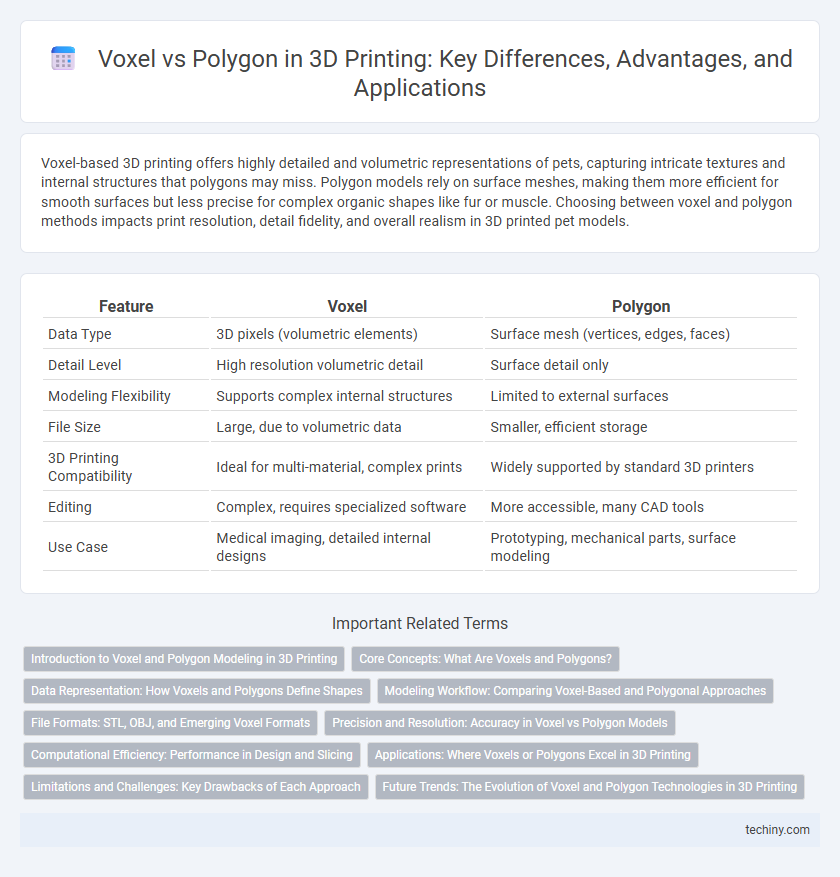Voxel-based 3D printing offers highly detailed and volumetric representations of pets, capturing intricate textures and internal structures that polygons may miss. Polygon models rely on surface meshes, making them more efficient for smooth surfaces but less precise for complex organic shapes like fur or muscle. Choosing between voxel and polygon methods impacts print resolution, detail fidelity, and overall realism in 3D printed pet models.
Table of Comparison
| Feature | Voxel | Polygon |
|---|---|---|
| Data Type | 3D pixels (volumetric elements) | Surface mesh (vertices, edges, faces) |
| Detail Level | High resolution volumetric detail | Surface detail only |
| Modeling Flexibility | Supports complex internal structures | Limited to external surfaces |
| File Size | Large, due to volumetric data | Smaller, efficient storage |
| 3D Printing Compatibility | Ideal for multi-material, complex prints | Widely supported by standard 3D printers |
| Editing | Complex, requires specialized software | More accessible, many CAD tools |
| Use Case | Medical imaging, detailed internal designs | Prototyping, mechanical parts, surface modeling |
Introduction to Voxel and Polygon Modeling in 3D Printing
Voxel modeling represents 3D objects as volumetric pixels, capturing detailed internal structures essential for complex medical and scientific applications in 3D printing. Polygon modeling constructs surfaces using vertices, edges, and faces, making it ideal for rendering smooth external geometries and widely used in industrial and consumer product design. Each method offers distinct advantages: voxels enable precise internal detail representation, while polygons provide efficient surface approximation and faster processing in 3D printing workflows.
Core Concepts: What Are Voxels and Polygons?
Voxels are volumetric pixels representing discrete units of volume in 3D space, essential for detailed, internal structure modeling in 3D printing. Polygons, primarily triangles or quads, form mesh surfaces that define the external geometry of 3D models, widely used for rendering and slicing processes. Understanding the voxel-based approach enables precise control over material distribution, while polygonal meshes optimize surface detail and computational efficiency.
Data Representation: How Voxels and Polygons Define Shapes
Voxels represent 3D shapes using volumetric pixels, capturing detailed internal structures by storing information in a uniform grid, which is ideal for complex or organic forms. Polygons define shapes through interconnected flat surfaces, typically triangles or quads, outlining external geometry with high precision but lacking interior data. This fundamental difference in data representation influences rendering techniques and application suitability in 3D printing workflows.
Modeling Workflow: Comparing Voxel-Based and Polygonal Approaches
Voxel-based modeling enables direct manipulation of volumetric data, allowing designers to create intricate internal structures essential for advanced 3D printing applications. Polygonal modeling relies on mesh-based surfaces, offering precise control over external geometry but often requiring additional steps to ensure model watertightness and printability. Workflow efficiency in 3D printing improves with voxel methods when structural complexity is prioritized, whereas polygonal approaches excel in scenarios demanding detailed surface refinement and compatibility with traditional CAD tools.
File Formats: STL, OBJ, and Emerging Voxel Formats
STL and OBJ file formats dominate 3D printing with polygon-based representations, capturing surfaces via vertices and faces for detailed mesh models. Emerging voxel formats like 3MF and VoxelX enable volumetric data storage, enhancing precision and material control by representing objects as discrete 3D pixels. Voxel formats facilitate advanced printing techniques such as multi-material and gradient structures, surpassing traditional polygonal file limitations in complexity and functional output.
Precision and Resolution: Accuracy in Voxel vs Polygon Models
Voxel-based 3D printing technology offers higher precision and resolution by representing objects as volumetric pixels, enabling detailed internal structures and smoother gradients that polygon models cannot achieve. Polygon models, composed of flat surfaces and edges, often suffer from resolution limitations due to mesh complexity, which may result in less accurate surface details and rougher edges. The voxel approach ensures superior accuracy in capturing complex geometries, critical for applications requiring fine detail and structural integrity.
Computational Efficiency: Performance in Design and Slicing
Voxel-based 3D printing processes handle volumetric data, enabling precise internal structure representation but requiring significant computational power for slicing and rendering. Polygonal models use mesh-based surfaces that are computationally lighter, allowing faster design manipulation and slicing performance, especially in complex geometries. The trade-off between detailed internal accuracy in voxel models and efficient processing in polygon models directly impacts the speed and resource consumption during 3D print preparation.
Applications: Where Voxels or Polygons Excel in 3D Printing
Voxels excel in medical imaging and complex anatomical modeling due to their ability to represent internal structures with detailed volumetric data, crucial for accurate surgical planning and prosthetics. Polygons dominate in industrial design and prototyping, offering efficient surface representation and compatibility with CAD software for streamlined manufacturing processes. Each structure suits distinct 3D printing applications based on the required precision of internal complexity versus external geometry.
Limitations and Challenges: Key Drawbacks of Each Approach
Voxel-based 3D printing faces limitations in processing speed and file size due to the massive amount of data required to represent high-resolution models, often leading to longer print times and increased computational load. Polygon-based models, while efficient for rendering surfaces, struggle with accurately representing complex internal structures and volumetric details, resulting in less precise and sometimes structurally weaker prints. Both approaches encounter challenges in balancing detail fidelity with resource consumption, impacting the scalability and practical applications in advanced manufacturing.
Future Trends: The Evolution of Voxel and Polygon Technologies in 3D Printing
Voxel-based 3D printing offers unparalleled precision by enabling full volumetric control within the printing process, allowing complex internal structures and material gradients unachievable with traditional polygon-based methods. Polygon technologies, rooted in surface mesh representations, continue to improve through advanced slicing algorithms and adaptive mesh refinement, optimizing print speed and material efficiency. Future trends suggest a hybrid approach combining voxel granularity with polygonal efficiency, driving innovations in multi-material printing and bioprinting with enhanced resolution and functional complexity.
Voxel vs Polygon Infographic

 techiny.com
techiny.com